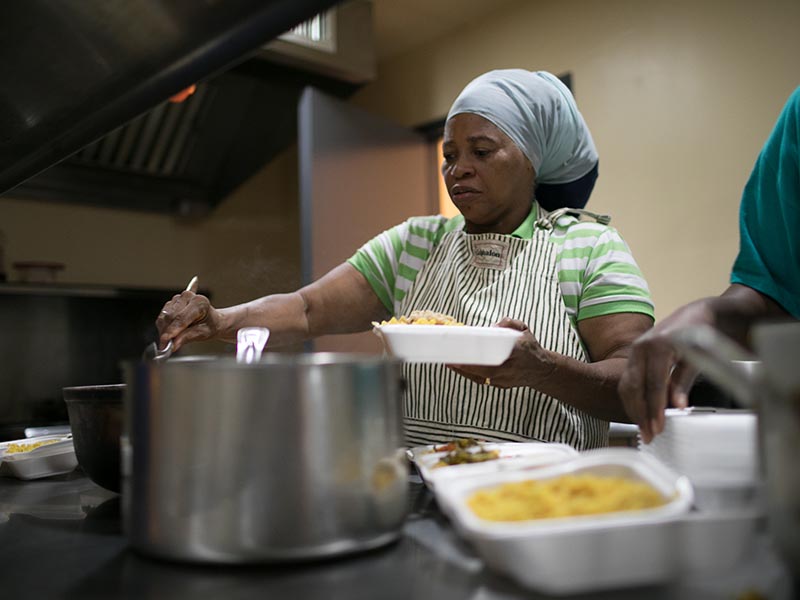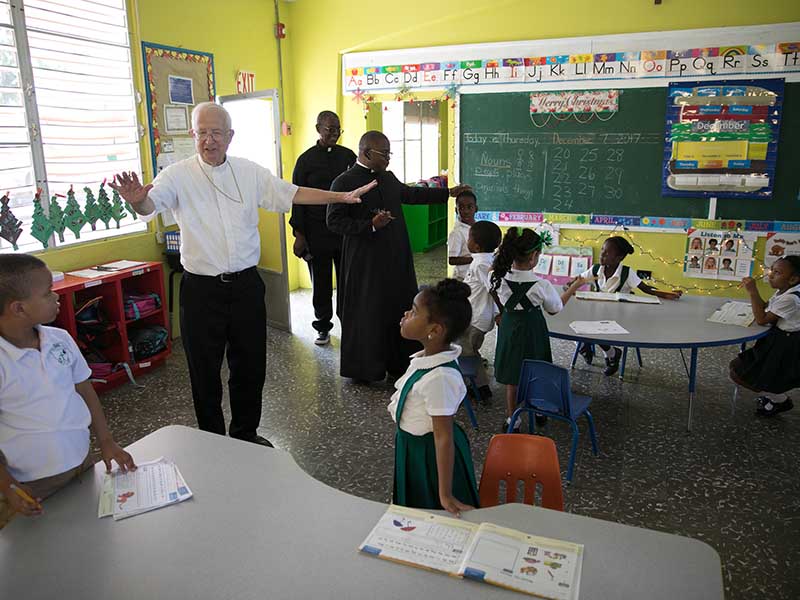[ad_1]
ST. CROIX, US Virgin Islands (RNS) – Reverend Louis Kemayou, an African native and hurricane novice, was in his church in St. Croix when Hurricane Maria hit this pristine island.
It was the night of September 21, and the roof of the Sts. Joachim and Ann Catholic Church began to tear each other apart.
The parish hall of the church of Saintes Anne and Joachim was destroyed. RNS Photo by Rich Kalonick / Catholic Extension
The frightened priest took refuge in the living room, where he crouched down and begged the sky: “God, I can no longer run. Please do your job! “
Kemayou showed me where he took refuge recently when I visited the island as part of a delegation from Catholic extension, which has provided some $ 3 million in support to the Diocese of St. Thomas since the 1960s. Catholic Extension has continued to provide aid since the US Virgin Islands were struck by Maria and Irma, two Category 5 hurricanes , just two weeks apart.
It turns out that the living room was the only place in the house that still had part of the roof intact. But the damage was typical of destruction caused by storms across the U.S. Virgin Islands, whose total land mass is only one-tenth that of Rhode Island.
[ad number=“1â€]
Bishop Herbert Bevard said virtually “every church and school†in his diocese has been affected. The local economy, heavily dependent on tourism, came to a screeching halt. And so with little income and a long road to the recovery to come, there is a deep sense of uncertainty.
Even before the hurricanes, the diocese had a small budget. It has only two and a half diocesan employees. But a budget doesn’t measure the size of his heart and his mind.
In the aftermath of the hurricanes, homeless shelters and Catholic-run soup kitchens have stepped up their efforts. The diocese plans to open another homeless shelter in the coming year to expand services to even more people.

An employee of a Catholic-run soup kitchen on St. Thomas Island prepares a fresh lunch on December 7, 2017. RNS Photo by Rich Kalonick / Catholic Extension
During our travels we have seen a lot of collapsed or damaged buildings and downed trees, but what left the deepest impression was just listening to the firsthand accounts of what it was like. to experience this unprecedented “punch†of maximum force storms.
Bevard, a native of Philadelphia who arrived in the Virgin Islands 10 years ago, had never experienced a severe hurricane. He said it was like lying in the middle of a railroad track as a train goes by for five non-stop hours. The only thing you can do is wait and hope you won’t be hit or dragged.
He spent the night fearful that every thud, every gust of wind blowing debris against the house, could be the start of something catastrophic.
Like Kemayou, many of Bevard’s 14 priests were also new to hurricanes. Reverend Boniface Blanchard Twaibu, originally from Congo, is pastor of Saint-Patrick’s Church in Frederiksted. The church, built in 1846, is a structure of striking beauty inside and out. As Maria beat the coastal town all night, Twaibu took refuge in an upper room of the old rectory. Outside he heard a loud crash – a stone wall on the side of the building collapsing like toy blocks. Fearing the whole building was about to collapse, he fled to the church, where he prayed and weathered the storm as the roof began to tear. Today, a blue tarp from the Federal Emergency Management Agency covers the church, which is currently unusable for public gatherings.
Bevard said his priests, who serve eight parishes and four schools in the diocese, are heroes.

Bishop Bevard welcomes kindergarten children on December 7, 2017, at St. Patrick’s School on the island of Sainte-Croix, VI. RNS Photo by Rich Kalonick / Catholic Extension
“They are with their people, they suffer with their people, and they alleviate the suffering of their people, both spiritual, emotional, psychological and physical,†he said.
Catholic schools in the islands provide a safe and nurturing environment for young people, who live in these island communities where drugs, prostitution, poverty and violence are sadly prevalent.
[ad number=“2â€]
At the Saint-Joseph de Sainte-Croix high school, one of the annex buildings of the school, where art and history are taught, was destroyed. Nonetheless, St. Joseph and all other Catholic schools resumed operations shortly after the hurricanes.
We met the senior high school senior class, whose members are still planning to go to college or join the military next year, and a number of them have already been accepted into universities. prominent contiguous United States.
[ad number=“3â€]
I have visited a number of hurricane-ravaged dioceses this year and have seen how such times of crisis can become unique opportunities for the Catholic Church to bear witness to what a community of faith is. Whether providing education for displaced students, charitable support for the poor, or spiritual care for those who have lost so much, the church brings hope to these devastated communities. These are the types of moments that will be remembered for generations, and the Diocese of St. Thomas realizes that this is the time to dig, not to give up.
As Father Kemayou noted, “What we do today is for generations to come.
(Joe Boland is the mission vice president at Catholic extension. The opinions expressed in this opinion piece do not necessarily reflect those of Religion News Service.)
[ad_2]

